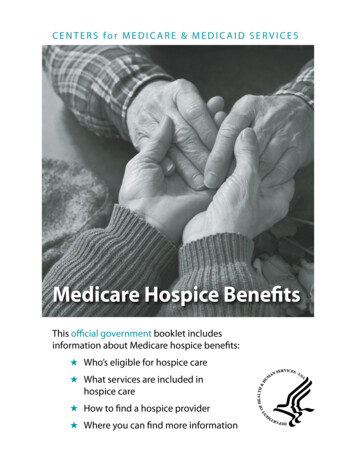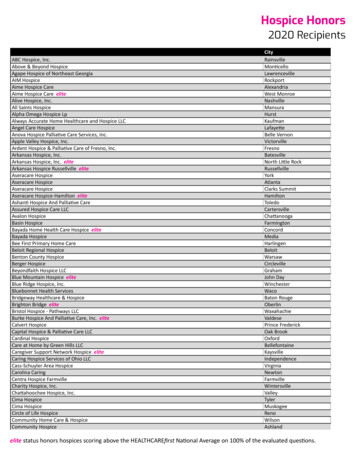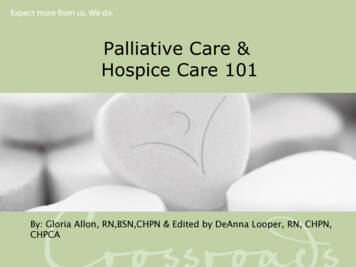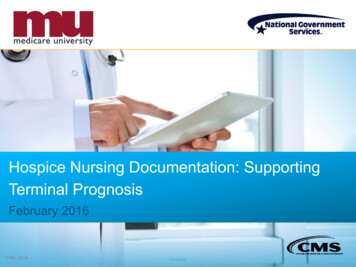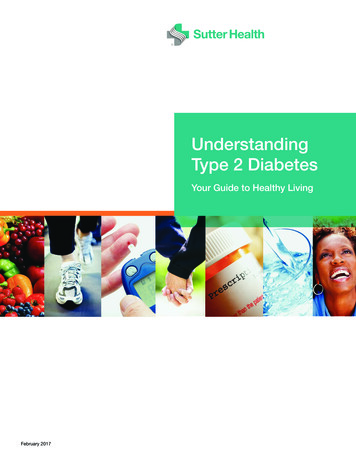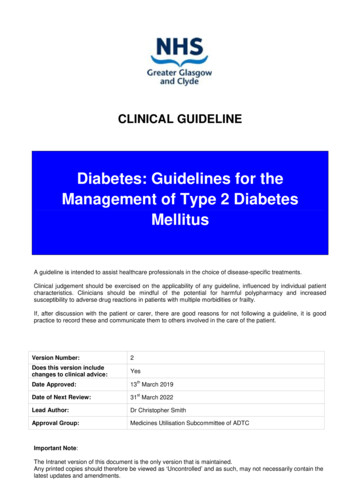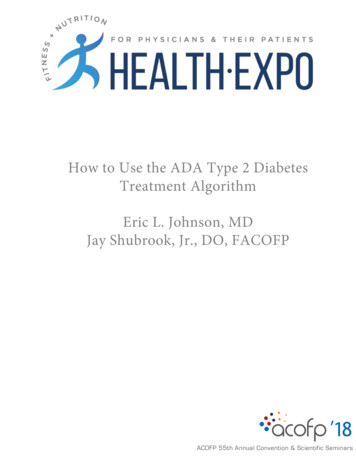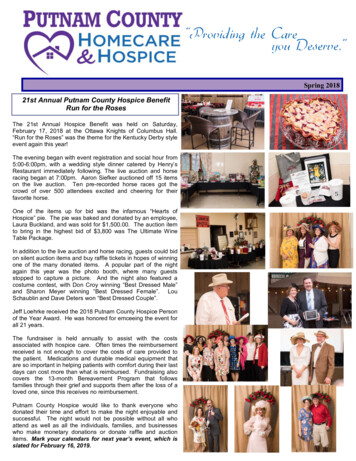
Transcription
5/13/2019Diabetes Management inHospice-Management ofAnti-DiabeticMedications and Insulinat End of LifeBy: Madeline Vallejo B.S. Pharm DMay 14 & 15, 2019Conflict of Interestand Disclosures ofRelevant FinancialRelationshipsThe planners andpresenters(spouse/domesticpartner) of thiseducational activity havedisclosed no healthcarerelated conflicts ofinterest, commercialinterest, or have anyrelated financialrelationships/support.The material in this presentation is for informational and educational purposes only and is not a substitute for medical advice, diagnosis, ortreatment provided by a qualified health care provider. All information contained in this presentation is protected by copyright and remains theproperty of ProCare HospiceCare. All rights are reserved.1
5/13/2019Contact Hours –Nursing1.0 Contact HourSuccessfulCompletion CriteriaProCare HospiceCare isaccredited as a providerof continuing nursingeducation by theAmerican NursesCredentialing Center’sCommission onAccreditation. (P-0544,3/31/2021) Register for theactivity Complete and submitthe sign in sheet View the entirepresentation Complete and submitthe participantevaluation Certificate will beemailed uponcompletion of thecriteriaThe material in this presentation is for informational and educational purposes only and is not a substitute for medical advice, diagnosis, ortreatment provided by a qualified health care provider. All information contained in this presentation is protected by copyright and remains theproperty of ProCare HospiceCare. All rights are reserved.2
5/13/2019Objectives Understand goals of therapy Identify the differences in the management of type 1 and type 2 diabetes Review signs and symptoms of hypo/hyperglycemia Review blood sugar targets and monitoring Understand reasons for discontinuation of certain drugs Diabetes treatments (insulin or non-insulin therapies) Discuss steroid induced diabetesIntroduction Estimated that 425 million people worldwide have diabetes Chronic disease associated with multiple complications It is also connected to an increased risk for the development of some types ofcancer Among the ten leading causes of death worldwide Increases with ageThe material in this presentation is for informational and educational purposes only and is not a substitute for medical advice, diagnosis, ortreatment provided by a qualified health care provider. All information contained in this presentation is protected by copyright and remains theproperty of ProCare HospiceCare. All rights are reserved.3
5/13/2019Diabetes Management standard goals Tight glycemic control to meet general targets Avoid acute decompensation To prevent tissue damage caused by too much sugar in the blood stream Prevent or delay the appearance of late disease complications Decrease mortality Maintain a good quality of life Avoid hypoglycemiaThe material in this presentation is for informational and educational purposes only and is not a substitute for medical advice, diagnosis, ortreatment provided by a qualified health care provider. All information contained in this presentation is protected by copyright and remains theproperty of ProCare HospiceCare. All rights are reserved.4
5/13/2019Diabetes Management in the HospicePatient Relieve current symptoms of disease Provide comfort to the patient One touch monitoring Target sugar levels Preserving quality of life No goal of achieving long-term positive outcomesGoals of a diabetic patient in hospicecare Minimize risk of hypoglycemia Simplified treatment regimens are preferred Painless and symptom free death Avoid metabolic de-compensation and related emergencies Avoid foot complications Avoid dehydration Monitor glucose lowering therapy Sole use of sliding scale should be avoidedThe material in this presentation is for informational and educational purposes only and is not a substitute for medical advice, diagnosis, ortreatment provided by a qualified health care provider. All information contained in this presentation is protected by copyright and remains theproperty of ProCare HospiceCare. All rights are reserved.5
5/13/2019Diabetes Type 1 Diabetes Type 2 Diabetes Steroid Induced DiabetesThe material in this presentation is for informational and educational purposes only and is not a substitute for medical advice, diagnosis, ortreatment provided by a qualified health care provider. All information contained in this presentation is protected by copyright and remains theproperty of ProCare HospiceCare. All rights are reserved.6
5/13/2019Monitoring Both Type 1 and Type 2 diabetes require reduced monitoring Insulin- 2-3 times per week Oral hypoglycemic- 1-2 times per weekTarget glucose in terminal illness 108-270mg/dlTarget glucose in later stages 108-360mg/dlThe material in this presentation is for informational and educational purposes only and is not a substitute for medical advice, diagnosis, ortreatment provided by a qualified health care provider. All information contained in this presentation is protected by copyright and remains theproperty of ProCare HospiceCare. All rights are reserved.7
5/13/2019Type 1 Diabetes Goal avoiding symptoms of hyper/hypoglycemia Little Monitoring Simplified insulin regimen Last days patient will require basal insulin and some pre-prandial short actinginsulin if still eatingThe material in this presentation is for informational and educational purposes only and is not a substitute for medical advice, diagnosis, ortreatment provided by a qualified health care provider. All information contained in this presentation is protected by copyright and remains theproperty of ProCare HospiceCare. All rights are reserved.8
5/13/2019Type 2 Diabetes Type 2 diabetes guidelines recommend less aggressive glycemic control forpatients with limited life expectancy Overly tight glycemic control in hospice patients include: Discussions about reducing or stopping chronic medications areuncomfortable Many patients and families believe that mild hyperglycemia can causesymptomsThe material in this presentation is for informational and educational purposes only and is not a substitute for medical advice, diagnosis, ortreatment provided by a qualified health care provider. All information contained in this presentation is protected by copyright and remains theproperty of ProCare HospiceCare. All rights are reserved.9
5/13/2019Factors affecting glycemic control inpatient’s with type 2 diabetes in EOL Stress response to severe or sustained illness Organ failure Malignancy Chemotherapy Use of steroids Frequent infections Poor appetite/smaller meals Cachexia/weight loss Dehydration Difficulty taking medicationsSymptoms of Hypoglycemia Shakiness Dizziness Sweating Hunger Irritability or moodiness Anxiety or nervousness HeadacheThe material in this presentation is for informational and educational purposes only and is not a substitute for medical advice, diagnosis, ortreatment provided by a qualified health care provider. All information contained in this presentation is protected by copyright and remains theproperty of ProCare HospiceCare. All rights are reserved.10
5/13/2019Symptoms of Hyperglycemia Increased thirst Fatigue Polyuria Dehydration Blurred vision Weight loss Headaches Urinary incontinence Electrolyte abnormalitiesHospice patients are at high risk ofhypoglycemia/hyperglycemia Anorexia/cachexia Progressive renal/hepatic impairment Bowel obstruction or vomiting Pancreatic cancerThe material in this presentation is for informational and educational purposes only and is not a substitute for medical advice, diagnosis, ortreatment provided by a qualified health care provider. All information contained in this presentation is protected by copyright and remains theproperty of ProCare HospiceCare. All rights are reserved.11
5/13/2019Blood sugar targets in hospice patients If patient is still testing A1C target 8.5% Random glucose 200mg/dlIf patient is not testing Discontinue as long as patient is comfortableLess aggressive glycemic treatment Reduce pill burden Finger sticks Laboratory monitoring If not on insulin and sugars stable Stop monitoringPrognosis weeks to days Only do prnThe material in this presentation is for informational and educational purposes only and is not a substitute for medical advice, diagnosis, ortreatment provided by a qualified health care provider. All information contained in this presentation is protected by copyright and remains theproperty of ProCare HospiceCare. All rights are reserved.12
5/13/2019Medications that can increase bloodsugars Benzodiazepines Thiazide diuretics Beta-blockers Steroids Birth control pills Progesterone Epi-pen Asthma inhalersManaging Type 2 Diabetes If oral medication causes hypoglycemia Stop or decrease intakeIf medications cause side effects Stop Avoid long-acting sulfonylurea preparations if small meals are taken Blood sugars 270mg/dl Insulin alone- basal insulin every day or twice daily Basal insulin will be increased with the use of the sliding scale Switch to insulinThe material in this presentation is for informational and educational purposes only and is not a substitute for medical advice, diagnosis, ortreatment provided by a qualified health care provider. All information contained in this presentation is protected by copyright and remains theproperty of ProCare HospiceCare. All rights are reserved.13
5/13/2019The material in this presentation is for informational and educational purposes only and is not a substitute for medical advice, diagnosis, ortreatment provided by a qualified health care provider. All information contained in this presentation is protected by copyright and remains theproperty of ProCare HospiceCare. All rights are reserved.14
5/13/2019Reasons to continue medication Patient has type 1 diabetes Patient is symptomatic from hyperglycemia Patient wants to continue to test blood sugar Patient has high PPS score with adequate intakeReasons for discontinuation ofmedication Tight glucose control only has a long term benefit Hyperglycemia in most cases are asymptomatic Terminal patients have a higher risk of hypoglycemia with reduced intake Frequent laboratory monitoring required Many medications are contraindicatedThe material in this presentation is for informational and educational purposes only and is not a substitute for medical advice, diagnosis, ortreatment provided by a qualified health care provider. All information contained in this presentation is protected by copyright and remains theproperty of ProCare HospiceCare. All rights are reserved.15
5/13/2019Diabetes medications are usuallydiscontinued at end of life Less side effects Less pills Risk vs benefit Impact on quality of life PPS scoreThe material in this presentation is for informational and educational purposes only and is not a substitute for medical advice, diagnosis, ortreatment provided by a qualified health care provider. All information contained in this presentation is protected by copyright and remains theproperty of ProCare HospiceCare. All rights are reserved.16
5/13/2019Insulin Rapid Short Intermediate Long Pre-mixed Sliding scaleThe material in this presentation is for informational and educational purposes only and is not a substitute for medical advice, diagnosis, ortreatment provided by a qualified health care provider. All information contained in this presentation is protected by copyright and remains theproperty of ProCare HospiceCare. All rights are reserved.17
5/13/2019The material in this presentation is for informational and educational purposes only and is not a substitute for medical advice, diagnosis, ortreatment provided by a qualified health care provider. All information contained in this presentation is protected by copyright and remains theproperty of ProCare HospiceCare. All rights are reserved.18
5/13/2019The material in this presentation is for informational and educational purposes only and is not a substitute for medical advice, diagnosis, ortreatment provided by a qualified health care provider. All information contained in this presentation is protected by copyright and remains theproperty of ProCare HospiceCare. All rights are reserved.19
5/13/2019Type 2 Diabetes Need to see when glucose is high with insulin Morning fasting high NPH in the eveningPost-prandial high AM NPH or Lantus /- pre-prandial or sliding scale (ultra short acting)If always high NPH BID or Lantus daily pre-prandial or sliding scaleThe material in this presentation is for informational and educational purposes only and is not a substitute for medical advice, diagnosis, ortreatment provided by a qualified health care provider. All information contained in this presentation is protected by copyright and remains theproperty of ProCare HospiceCare. All rights are reserved.20
5/13/2019General Nutrition “Diabetic” diet have been prescribed in the past LTC have shifted to offering a wider variety of food choices (more liberal) “no sugar” diet orders are ineffective for glycemic management and shouldbe avoided Consistent carbohydrate meal planEnteral nutrition support Diabetes specific enteral nutrition Glucerna Glytrol DiabetisourceManage glycemic index during tube feedingsThe material in this presentation is for informational and educational purposes only and is not a substitute for medical advice, diagnosis, ortreatment provided by a qualified health care provider. All information contained in this presentation is protected by copyright and remains theproperty of ProCare HospiceCare. All rights are reserved.21
5/13/2019Steroid induced diabetes Abnormal increase in blood glucose associated with the use of glucocorticoidsin a patient with or without a prior history of diabetes mellitus Criteria for diagnosis by the American Diabetes Association 8 hr fasting blood glucose 126mg/dl 2 hr post 75 g oral glucose tolerance test 200mg/dl A1C 6.5% Random plasma glucose of 200mg/dl Patient with symptoms of hyperglycemiaSteroid induced diabetes Monitor blood sugar with start of steroid therapy Symptoms Hyperglycemia is worse post-prandial and late in the day Can use NPH or Lantus in the morning with sliding scale Decreasing steroid is an option Glucose may take some time to get back to normalThe material in this presentation is for informational and educational purposes only and is not a substitute for medical advice, diagnosis, ortreatment provided by a qualified health care provider. All information contained in this presentation is protected by copyright and remains theproperty of ProCare HospiceCare. All rights are reserved.22
5/13/2019General recommendationsPrognosis- Years Maximizing glycemic control according to nations guideline to prevent longterm complications, A1C 7% Blood pressure 140/80 mmHg In patients with Type 2 always use short acting sulphonylureas to reduce therisk of hypoglycemia especially in elderlyGeneral recommendationsPrognosis- Months Relax BG targets aiming for BG levels 145-270mg/dl range Want patients to be symptom free Type 2 –consider stopping oral antidiabetic agents and use once daily longacting insulinThe material in this presentation is for informational and educational purposes only and is not a substitute for medical advice, diagnosis, ortreatment provided by a qualified health care provider. All information contained in this presentation is protected by copyright and remains theproperty of ProCare HospiceCare. All rights are reserved.23
5/13/2019General recommendationsPrognosis- Days or weeks Avoid hypoglycemia Try and limit symptomatic hyperglycemia Avoid unnecessary monitoringPrognosis- Years Type 1 diabetes Type 2 diabetes Usual BG monitoring and insulin regimen If diet controlled and on oral anti-diabetic agents- no routine patient monitoringrecommended If found to be persistently hyperglycemic start on oral antidiabetic agents Usually no need for sliding scale insulinSteroid induced diabetes Patients on dexamethasone 4mg check BG if symptomatic Hyperglycemia is directly linked to steroid dose Consider check BG if symptomatic hyperglycemia is present or patients conditionchangesThe material in this presentation is for informational and educational purposes only and is not a substitute for medical advice, diagnosis, ortreatment provided by a qualified health care provider. All information contained in this presentation is protected by copyright and remains theproperty of ProCare HospiceCare. All rights are reserved.24
5/13/2019Prognosis- Months Type 1 diabetes Usual BG monitoring and insulin regimen If oral intake decreasing consider altering insulin regimenType 2 diabetes If diet controlled and on oral anti-diabetic agents no routine patient monitoringrecommended If found to be persistently hyperglycemic consider burden/benefit of treatment If oral intake decreasing may want to reduce or stop oral antidiabetic agents If on insulin should keep same monitoring regimen If on insulin, consider once daily long-acting insulinSteroid induced diabetes Consider check BG if symptomatic hyperglycemia Reducing steroid will likely improve hyperglycemiaPrognosis- Days or Weeks Type 1 diabetes BG should be checked at time of admission If BG 72mg/dl manage as hypoglycemia If BG 180mg/dl reduce long acting or intermediate acting insulin dose by ½ If BG 270mg/dl and patient is conscious- continue regular long acting or intermediateacting insulin dose and continue daily BG’s If BG 270mg/dl and patient is unconscious- reduce long acting or intermediate actinginsulin dose by ½ Not enough evidence to support to stop insulin in this group of patients Once daily BGs can be continued or discontinued if stableThe material in this presentation is for informational and educational purposes only and is not a substitute for medical advice, diagnosis, ortreatment provided by a qualified health care provider. All information contained in this presentation is protected by copyright and remains theproperty of ProCare HospiceCare. All rights are reserved.25
5/13/2019Prognosis- Days or Weeks Type 2 diabetes If diet controlled no routine checks required Reduce or stop oral diabetic medications and just observe for symptoms BG should be checked at time of admission If BG 72mg/dl manage as hypoglycemia If BG 180mg/dl and patient is conscious- stop insulin or reduce long acting/intermediateacting insulin dose by ½ If BG 180mg/dl and patient is in dying phase- stop insulin If BG 270mg/dl and patient is conscious- continue regular long acting or intermediateacting insulin dose and continue daily BG’s If BG 270mg/dl and patient is unconscious-stop insulinPrognosis- Days or Weeks Steroid induced diabetes Steroids will most likely be reduced or discontinued No need for routine BG monitoringThe material in this presentation is for informational and educational purposes only and is not a substitute for medical advice, diagnosis, ortreatment provided by a qualified health care provider. All information contained in this presentation is protected by copyright and remains theproperty of ProCare HospiceCare. All rights are reserved.26
5/13/2019Case Study #1 DG is a 64yo male with type 1 diabetes admitted to your hospice. His bloodglucose level is 80mg/dl. He tells you he takes NPH(Humulin R) insulin 40units every morning and Regular(Humulin R) insulin with each meal and atbedtime. What are some possible reasons that BG dropped lower than usual?Case Study #2 MS is a 74yo man with type 2 diabetes. He has a history of coronary arterydisease, frequent falls, and mild dementia. His intake is declining and PPS is10%. He is currently on basal insulin, metformin, and glyburide. Whichmedication(s) should be discontinued and why?The material in this presentation is for informational and educational purposes only and is not a substitute for medical advice, diagnosis, ortreatment provided by a qualified health care provider. All information contained in this presentation is protected by copyright and remains theproperty of ProCare HospiceCare. All rights are reserved.27
5/13/2019Summary Goals for diabetes management at end of life Promoting comfort Controlling symptoms Avoid dehydration Avoiding ER and hospital visits Preserving quality of life Decreasing complexity of treatment Important to respect a patient’s right to refuse treatment and withdraw oralhypoglycemic agents and/or stop insulin at end of life Don’t forget diabetic nurse and dieticianQuestions? mvallejo18@yahoo.comThe material in this presentation is for informational and educational purposes only and is not a substitute for medical advice, diagnosis, ortreatment provided by a qualified health care provider. All information contained in this presentation is protected by copyright and remains theproperty of ProCare HospiceCare. All rights are reserved.28
5/13/2019References Diaz Rodriguez JJ. “Perspective and general approach of diabetes in palliativecare” Hos Pal Med Int Jnl. 2018;2(3): 197-202. SJ Lee, MA Jacobson, and CB Johnston. “Improving Diabetes Care for HospicePatients” American Journal of Hospice and Palliative medicine. 2016;33(6):517-519. MN Munshi, H Florez, ES Huang, et al. “Management of Diabetes in Long-termCare and Skilled Nursing Facilities: A Position Statement of the AmericanDiabetes Association” Diabetes Care. 2016;39:308-318. K Quinn, P Hudson, and T Dunning. “Diabetes Management in PatientsReceiving Palliative Care” J Pain Symptom Manage 2006;32:275-286.The material in this presentation is for informational and educational purposes only and is not a substitute for medical advice, diagnosis, ortreatment provided by a qualified health care provider. All information contained in this presentation is protected by copyright and remains theproperty of ProCare HospiceCare. All rights are reserved.29
at End of Life By: Madeline Vallejo B.S. Pharm D May 14 & 15, 2019 Conflict of Interest and Disclosures of Relevant Financial Relationships The planners and presenters (spouse/domestic partner) of this educational activity have .

